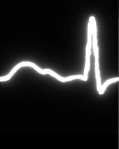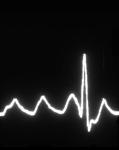Luckily I have many cardio-familiar friends to ask for advice. To depict the most realistic heartbeat, I chose three images of heart readings: Normal Sinus Rhythm (where the heart is functioning normally – 60-100 beats/min), Sinus Tachycardia (increased workload of the heart and clinical significance, >100-150 beats/min) and Atrial Flutter (damaged hearts, 259-350 beats/min). Heart beat scenarios will coordinate with drum beat frequency. Slower beats are ideal and trigger normal heart beat rhythms. Faster beats trigger unhealthy heart rate. The significance being that the drum responds positively to some types of interaction and negatively to others, much like any living being. The goal is to find the sweet spot.
Prior to triggering the scenarios shows in the gallery, I was coding the individual parts of the heart beat. These parts can be seen in the QRT image in the gallery. Each part had a specific math formula that was called. This was the transitory solution to making a more realistic heartbeat. If you look at my previous heartbeats they were simple pos/neg sloped lines. The problem is that calling the formulas is messy in code so David Bouchard suggested I simply call a animation (scenario). I added the glow effect on top of it. Sadly the glow effect was only able to superimpose on images that had a dark background and a light line. Thats why in future version (where the background is sandy and the line is tan, the glow effect does not work).



